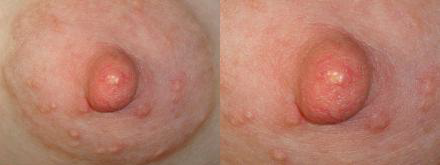White spot on the nipple
White spot on the nipple
 A white spot on the nipple usually occurs in breastfeeding women, but can occur at other times. It is also referred to as a blocked nipple pore, a bleb or a milk blister. It is usually about the size of a pinhead or a little larger. The skin surrounding the white spot may be red and inflamed. A white spot can cause nipple pain, especially during a breastfeed.
A white spot on the nipple usually occurs in breastfeeding women, but can occur at other times. It is also referred to as a blocked nipple pore, a bleb or a milk blister. It is usually about the size of a pinhead or a little larger. The skin surrounding the white spot may be red and inflamed. A white spot can cause nipple pain, especially during a breastfeed.
The blockage is usually caused by either an overgrowth of skin or a small amount of thickened milk. This creates a blocked duct at the nipple tip and may be associated with mastitis. There may be a hard ridge of breast tissue leading away from the nipple due to milk accumulation.
When a white spot is present on the nipple and is causing pain, correct attachment is important to reduce pain with feeding.
When the baby feeds from the breast that has the white spot, the fragile layer of skin over the white spot can sometimes burst or the thickened milk can move, thereby releasing the milk from the duct behind it. In this way, a white spot can sometimes resolve itself.
If this fails to resolve it, the nipple can be soaked in warm water and then gently rubbed with a wet face-washer. Olive oil massaged into the affected nipple may also help soften and break up the blockage.
When the above measures are unsuccessful at removing the white spot, a doctor can use a sterile needle to gently release the blockage. Instant relief often follows the disappearance of the white spot. Unfortunately, for some mothers, the problem seems to recur. In these situations, you may find it helpful to gently rub the nipple with a face washer daily in the shower to help prevent recurrence.
References:
- Walker M, (2010), The nipple and areola in breastfeeding and lactation: anatomy, physiology, problems and solutions, Clinics in Human Lactation. Vol 7. Amarillo,Texas: Hale Publishing.
- Day J, (2001), Report of Australian Breastfeeding Association white spot study, Topics in Breastfeeding. Set X11(Dec):1–10
- Campbell SH, (2006), Recurrent plugged ducts, J Hum Lact, 22(3):340-343.
Adapted from the Australian Breastfeeding Association website, written February 2012
 A white spot on the nipple usually occurs in breastfeeding women, but can occur at other times. It is also referred to as a blocked nipple pore, a bleb or a milk blister. It is usually about the size of a pinhead or a little larger. The skin surrounding the white spot may be red and inflamed. A white spot can cause nipple pain, especially during a breastfeed.
A white spot on the nipple usually occurs in breastfeeding women, but can occur at other times. It is also referred to as a blocked nipple pore, a bleb or a milk blister. It is usually about the size of a pinhead or a little larger. The skin surrounding the white spot may be red and inflamed. A white spot can cause nipple pain, especially during a breastfeed.
The blockage is usually caused by either an overgrowth of skin or a small amount of thickened milk. This creates a blocked duct at the nipple tip and may be associated with mastitis. There may be a hard ridge of breast tissue leading away from the nipple due to milk accumulation.
When a white spot is present on the nipple and is causing pain, correct attachment is important to reduce pain with feeding.
When the baby feeds from the breast that has the white spot, the fragile layer of skin over the white spot can sometimes burst or the thickened milk can move, thereby releasing the milk from the duct behind it. In this way, a white spot can sometimes resolve itself.
If this fails to resolve it, the nipple can be soaked in warm water and then gently rubbed with a wet face-washer. Olive oil massaged into the affected nipple may also help soften and break up the blockage.
When the above measures are unsuccessful at removing the white spot, a doctor can use a sterile needle to gently release the blockage. Instant relief often follows the disappearance of the white spot. Unfortunately, for some mothers, the problem seems to recur. In these situations, you may find it helpful to gently rub the nipple with a face washer daily in the shower to help prevent recurrence.
References:
- Walker M, (2010), The nipple and areola in breastfeeding and lactation: anatomy, physiology, problems and solutions, Clinics in Human Lactation. Vol 7. Amarillo,Texas: Hale Publishing.
- Day J, (2001), Report of Australian Breastfeeding Association white spot study, Topics in Breastfeeding. Set X11(Dec):1–10
- Campbell SH, (2006), Recurrent plugged ducts, J Hum Lact, 22(3):340-343.
Adapted from the Australian Breastfeeding Association website, written February 2012

A white spot on the nipple usually occurs in breastfeeding women, but can occur at other times. It is also referred to as a blocked nipple pore, a bleb or a milk blister. It is usually about the size of a pinhead or a little larger. The skin surrounding the white spot may be red and inflamed. A white spot can cause nipple pain, especially during a breastfeed.
The blockage is usually caused by either an overgrowth of skin or a small amount of thickened milk. This creates a blocked duct at the nipple tip and may be associated with mastitis. There may be a hard ridge of breast tissue leading away from the nipple due to milk accumulation.
When a white spot is present on the nipple and is causing pain, correct attachment is important to reduce pain with feeding.
When the baby feeds from the breast that has the white spot, the fragile layer of skin over the white spot can sometimes burst or the thickened milk can move, thereby releasing the milk from the duct behind it. In this way, a white spot can sometimes resolve itself.
If this fails to resolve it, the nipple can be soaked in warm water and then gently rubbed with a wet face-washer. Olive oil massaged into the affected nipple may also help soften and break up the blockage.
When the above measures are unsuccessful at removing the white spot, a doctor can use a sterile needle to gently release the blockage. Instant relief often follows the disappearance of the white spot. Unfortunately, for some mothers, the problem seems to recur. In these situations, you may find it helpful to gently rub the nipple with a face washer daily in the shower to help prevent recurrence.
References:
- Walker M, (2010), The nipple and areola in breastfeeding and lactation: anatomy, physiology, problems and solutions, Clinics in Human Lactation. Vol 7. Amarillo,Texas: Hale Publishing.
- Day J, (2001), Report of Australian Breastfeeding Association white spot study, Topics in Breastfeeding. Set X11(Dec):1–10
- Campbell SH, (2006), Recurrent plugged ducts, J Hum Lact, 22(3):340-343.
Adapted from the Australian Breastfeeding Association website, written February 2012








